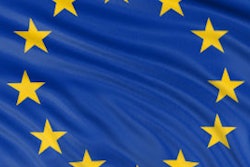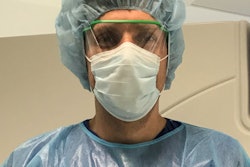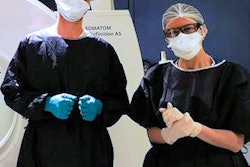
"I think everyone on the planet knows what COVID-19 is." No truer words have ever been spoken than those from Dr. Nivedita Agarwal of Ospedale Santa Maria Del Carmine Hospital in Trento, Italy.
Her comments came during a global virtual roundtable on 15 April, organized by the International Society for Magnetic Resonance in Medicine (ISMRM) and the Society for MR Radiographers and Technologists (SMRT) to discuss how radiologists, clinicians, and healthcare practitioners in different parts of the world are handling the COVID-19 pandemic.
"Italy was the first Western country hit by the COVID-19 coronavirus and unfortunately was unprepared for the onslaught of cases," Agarwal reflected. "We were overwhelmed by the number of patients requiring assistance. Unfortunately, older people could not get into the hospital and probably died in their homes in a matter of days because there was no capacity [in the hospitals]. Now the healthcare system can take care of pretty much everyone."
COVID-19 outbreak
In the initial days of the novel coronavirus, Italian clinicians turned to chest x-rays to determine if patients had COVID-19, but they soon moved to CT as they "gained experience from data coming out of China every day," Agarwal said.
"We started learning from [the Chinese], which helped change the way we dealt with, for example, chest x-rays and CT to determine the presence of COVID-19, as well as ultrasound, in the emergency room," Agarwal said. "We are ordering chest CT for all patients coming to the hospital, which tells us the level of lung involvement in our patients."
The most recent numbers from Italy show more than 165,000 COVID-19 cases and approximately 21,600 deaths. Most adversely affected was the province of Milan in the Lombardy region of northern Italy. Because it is such a hugely popular tourist area, the outbreak quickly mushroomed to more than 62,000 confirmed cases of COVID-19 and approximately 11,300 deaths.
Over the past month, the number of COVID-19 cases in the country has plateaued and is on the decline, due in part to the Italian government's implementation of social distancing and lockdowns with the slogan "I Oresta A Cass" (English translation: "I am staying home").
"The most important lesson here is that these restrictive measures are actually working," Agarwal said.
Of course, the SARS-CoV-2 virus is not just spreading through Italy but also across the world, with some 125 countries having to deal with this pandemic. As of 15 April, about 2 million cases of COVID-19 have been reported worldwide and approximately 129,000 deaths have been attributed to the respiratory disease. Other countries, however, have had the added advantage of seeing what clinical measures work and which approaches do not.
Dr. Chris Kokkinos is a radiographer and operations manager at Epworth Hospital Richmond in Melbourne, Australia, one of the largest nonprofit private hospitals in the country. The 700-bed facility has instituted several strategies throughout the hospital to better protect its patients and staff. As of 15 April, Australia had recorded 6,400 cases of COVID-19, with 61 deaths and 3,598 patients who have recovered from the novel coronavirus.
"A lot of what we are doing is dealing with the calm before the storm," added Kokkinos, the former president of SMRT. "There are opportunities to learn from the experiences of other countries, what worked and what didn't, and how things evolved as they went along."
Reallocating resources
Epworth primarily serves outpatient, elective surgical cases, but it most recently transitioned many of its functions to respond to the COVID-19 crisis. The emergency department, which operates 24/7, is "significantly busier," Kokkinos said, and there has been a "massive shift" by Epworth to convert some of its 43 surgical rooms into bed space for patients if COVID-19 cases increase.
"We are coordinating with the emergency department and the [intensive care unit] clinicians, but things have not escalated as quickly as we thought -- which is great -- but we are expecting that it will at some point," he added. "In the meantime, we try to balance inpatient and outpatient services and how we manage those COVID-19 demands, whilst managing the expectations of our staff who have many questions. It is quite challenging as management to answer questions when we are trying to work out what those answers will be ourselves."
To minimize unnecessary interaction between its radiologists and to encourage internal social distancing, the facility three weeks ago divided its radiology group into four teams to rotate three eight-hour shifts each day, rather than the previous scheme of overlapping shifts. Epworth also lined the floor of its radiology workspaces with red tape in the shape of large triangles to separate radiologists' workstations and added yellow-taped Xs on the floor to designate how far to stand apart from each other.
"Even for staff, there is not only the fear of contracting the virus but also the fear of passing it on to others or to patients," he said. "Early on, we had five or six staff members saying, 'I have a bit of a cough; should I or should I not get tested?'" They do not want to compromise the care of other people. Our position now is that anyone who has symptoms has to be tested because we're looking to flatten that [COVID-19] curve within the healthcare sector."
As for the clinical modifications, Epworth is looking to increase its mobile x-ray capacity and repurpose existing equipment, which includes setting up a mobile CT scanner in-house to exclusively handle COVID-19 patients. The facility also is looking at the possibility of using interventional x-ray systems with image intensifiers to perform chest x-rays in the event of a surge of COVID-19 patients.
Caring for staff
Another challenge is how to handle personal protection equipment (PPE). The protocols also include the need to evaluate who uses PPE and how they use it, ensuring both that people are kept safe and that PPE is preserved for possible future escalations of COVID-19 cases. Naturally, the protection extends to all staff at Epworth.
"It is not just radiographers. We have our sonographers who are performing bedside ultrasound, the interventionalists who are doing procedures, and our nursing staff," Kokkinos said. "There are other staff members who are so important; the orderlies and the cleaners who will mix with a lot of different patients. We need to get our practices right, particularly for those groups, when we look at limiting the transmission or spread of COVID-19 within our organization."
Given that the COVID-19 pandemic is still expected to hit every region of the globe, now is not the time to relax preventive measures that are already in place, healthcare experts advocate.
"We have to make sure that our preventive measures are taken seriously by the government; and if not by the government, by the people, each one of us, to prevent a second or third wave," Agarwal said.



















